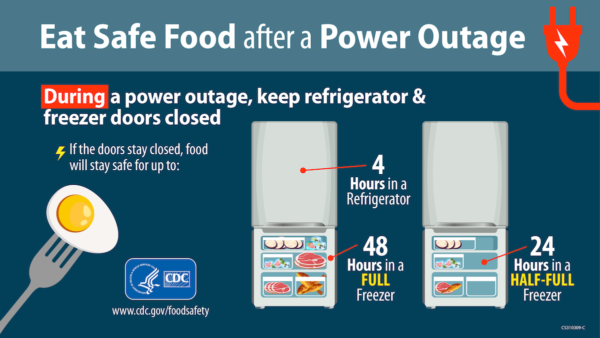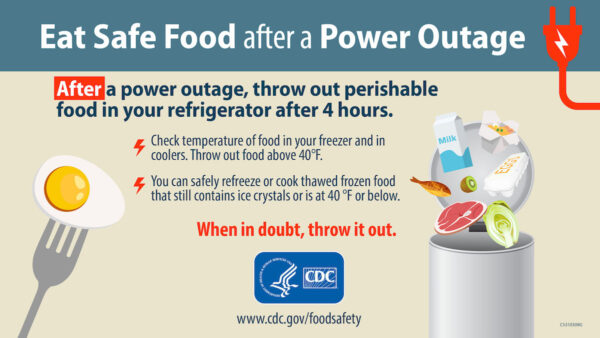In the past, over on my other blog, I’ve covered topics about expiration dates. This includes understanding food expiration dates and does medicine expire. However, when we’re talking about how to tell if food has gone bad after a power outage, you can toss all those dates out the window.
How to Tell if Food is Bad After a Power Outage
There’s one simple reason you don’t want to eat food that may have gone bad during a power outage: you could get very, very sick. Here are some tips and a timeline for knowing that food has gone bad when the power goes out.

Food in the refrigerator and freezer
According to the Centers for Disease Control, food can stay edible in a refrigerator or freezer during a power outage, as long as the doors have remained closed. However, there is a time limit, even with the doors closed, after which you should toss all food.
For example, if the doors stay closed, food will stay safe for up to four hours in a refrigerator that has lost power. With the freezer, you have more time.
If you have a full freezer, then you likely have 48 hours (again, with doors closed while the power is out) before things start to thaw and spoil. However, what if your freezer is only half full? Well, after 24 hours, that food is no longer safe to eat.
How to handle food that may have gone bad

Don’t be a martyr and decide to eat food that could be iffy. You could end up with a food-borne illness, such as salmonella.
If you’re a SNAP EBT recipient, you can get your food benefits replaced. It might not be right away but there are safeguards in place.
Here are additional tips to keep in mind about food that may have gone bad after a power outage.
- Never taste food to determine if it is safe to eat. When in doubt, throw it out.
- Throw out perishable food in your refrigerator (meat, fish, cut fruits and vegetables, eggs, milk and leftovers) after four hours.
- Throw out any food with an unusual odor, color, or texture.
- Check temperatures of food kept in coolers or your refrigerator. Throw out food above 40 degrees.
With regards to food in a freezer after a power outage, if you have an appliance thermometer in your freezer, check to see if it is still at 40 degrees F or below. If it is, you can safely refreeze or cook thawed frozen food that still contains ice crystals or is at 40 degrees F or below. However, if it’s been more than 48 hours since the power went out, you’re probably safest just throwing that food away.
Food and cooking equipment after a flood
Now that we’ve covered how to know if food has gone bad during a power outage, there is something else Mainers need to keep in mind: food and cooking equipment that came into contact with flood water.
For example, if you have commercially canned foods that may have been submerged in flood waters, there is a chance you can clean them off and use them. However, the USDA recommends looking for any signs of damage that might indicate the food inside is compromised. Some of those signs include:
- swelling
- leakage
- punctures
- holes
- fractures
- extensive deep rusting
- crushing/denting severe enough to prevent opening with a manual, wheel-type can opener
What about non-canned goods? The USDA recommends discarding any food that is not in a waterproof container that may have come into contact with flood water.
Food containers that are not waterproof include those with the following:
- screw-caps
- snap lids
- pull tops
- crimped caps
Also, discard cardboard juice/milk/baby formula boxes and home canned foods because they cannot be effectively cleaned and sanitized.
Cleaning cooking equipment
As far as cooking equipment goes, you can use them after a flood. However, you must clean them properly beforehand. Running them through the dishwasher with the hottest water possible plus dishwasher detergent is a good first step.
Or, the USDA says you can clean and sanitize your metal pans, ceramic dishes and utensils (including can openers) by immersing them for 15 minutes in a solution of 1 tablespoon of unscented, liquid chlorine bleach per gallon of drinking water (or the cleanest, clearest water available, such as bottled water).
Free and Cheap Things To Do in Southern Maine This Week
Here are FREE and cheap things to do in Southern Maine in the coming week.